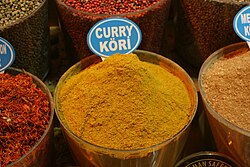カレー粉
Curry powder/ja
| カレー粉 | |
|---|---|
 | |
| 種類 | カレー |
| 地域 | インド亜大陸 |
| 主な材料 | スパイス (コリアンダー, ターメリック, クミン, チリペッパー) |
カレー粉は、インド亜大陸発祥のカレー用のスパイスミックスであり、現地のスパイスミックスであるガラムマサラから派生したものであるが、それと混同してはならない。
歴史
西洋市場で商業的に入手可能なカレー粉は、伝統的なインドのスパイス混合物であるガラムマサラ('温かいスパイス'の意)に匹敵する。
インドのソースの風味を再現することを意図した既製の材料として考案され、最初にインドの商人がイギリスの貿易商に販売したものである。
Curry powder was used as an ingredient in 18th-century British recipe books, and commercially available from the late 18th century, with brands such as Crosse & Blackwell and Sharwood's persisting to the present. In Australia, a common curry spice is Keen’s curry powder. The ingredient "curry powder", along with instructions on how to produce it, are also seen in 19th-century US and Australian cookbooks, and advertisements.
British traders introduced the powder to Meiji Japan, in the mid-19th century, where it became known as "Japanese curry", and evolved into a distinct dish.
Etymology
In the West, the word "curry" is a broad reference to various Indian dishes prepared with different combinations of spices in the Indian subcontinent. The sauce-like component characterized by "curry" has been derived from the Tamil word kaṟi meaning literally 'sauce' or 'relish for rice', and finds synonyms with other regional references to local dishes evolving over thousands of years in the Indian subcontinent, such as jhol, shorba and kalia.
Ingredients
A number of standards on curry powder have been defined. Most outline analytical requirements such as moisture, ash content, and oil content as well as permissible additives. Some also define a number of expected ingredients.
In the United States, curry powder is expected to contain at least these ingredients: turmeric, coriander, fenugreek, cinnamon, cumin, black pepper, ginger, and cardamom.
The 1999 East African Standard (EAS 98:1999) does not define an ingredient baseline. A newer 2017 draft from Uganda does require turmeric, coriander, cumin, fenugreek and mustard.
The Indian (FSSAI), Pakistani (PS:1741–1997), and international (ISO 2253:1999) standards do not define a baseline of essential ingredients.
Nutritional information
One tablespoon (6.3 g) of typical curry powder contains the following nutrients according to the USDA:
- Food energy: 84 kJ (20 kcal)
- Fat: 0.883 g
- Carbohydrates: 3.52 g
- Fibers: 3.35 g
- Protein: 0.9 g
| この記事は、クリエイティブ・コモンズ・表示・継承ライセンス3.0のもとで公表されたウィキペディアの項目Curry powder(30 April 2025, at 18:07編集記事参照)を翻訳して二次利用しています。 |